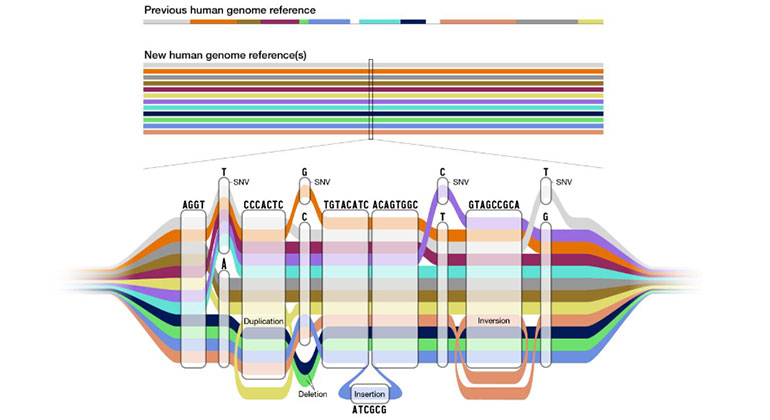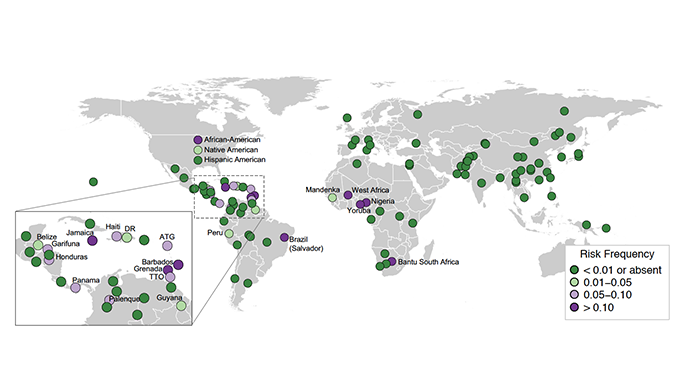Genetic Ancestry Versus Race Can Provide Specific, Targeted Insights to Predict and Treat Many Diseases
The complex patterns of genetic ancestry uncovered from genomic data in health care systems can provide valuable insights into both genetic and environmental factors underlying many common and rare diseases—insights that are far more targeted and specific than those derived from traditional ethnic or racial labels like Hispanic or Black, according to a team of Mount Sinai researchers.
In a study in the journal Cell, the team reported that this information could be used to better understand and predict which populations are more susceptible to certain disorders—including cancers, asthma, diabetes, and cardiovascular disease—and to potentially develop early interventions.
“This is the first time researchers have shown how genetic ancestry data could be used to enhance our understanding of disease risk and management at a health system level,” says senior author Eimear Kenny, PhD, Professor of Medicine, and Genetics and Genomic Sciences, at the Icahn School of Medicine at Mount Sinai. “By linking this data directly to health outcomes, we believe we’re contributing to an ongoing conversation to move beyond the current role of race and ethnicity in medicine.”
The research team drew from Mount Sinai’s BioMe™ BioBank program, recognized as one of the world’s leading repositories of genomic information for diverse populations, for its study. Using machine learning methodology, scientists identified 17 distinct ethnic communities from among the 30,000 participants in the BioMe BioBank. They then linked this data to thousands of health outcomes residing in Mount Sinai’s electronic health records. Among the findings was that 25 percent of BioMe participants had genetic links to populations—such as Ashkenazi Jewish and Puerto Rican—that predisposed them to certain genetic diseases.
“The traditional use of demographic data by health systems fails to capture the rich ethnic heritage of patients, and thus all the genetic and environmental factors that can affect rates of disease even within the same population,” says Dr. Kenny, who is Founding Director of the Institute for Genomic Health at Mount Sinai. “Our study used genomic data embedded in health system records to show how patients with origins from different countries in the Americas can have different rates of disease. For example, people of Puerto Rican and Mexican descent are broadly classified as Hispanic or Latinx, yet the former population has one of the highest rates of asthma in the world, while the latter population has one of the lowest.”
The Mount Sinai study cited the APOL1 gene, which can confer a significantly greater risk of kidney and cardiovascular disease, as another reason for moving beyond the traditional demographic labels used by health care systems. The risk variants of APOL1 are most frequently seen in populations across the Americas that share African genetic ancestry. However, there are many populations around the world of African descent that might not self-identify as African, and thus be unaware that they might harbor those risk variants. Furthermore, that knowledge gap may result in these populations being underrepresented in APOL1 research.
“Our study underscores that there are limits to the narrow demographic labels used in medicine and research today—and society in general, for that matter—to attempt to characterize disease and its risk factors,” says Dr. Kenny. “The types of information that can be derived from using biological markers of ancestry, however, convey a much richer and more sophisticated layer of understanding of disease risk and burden, one that could have enormous implications for health care systems globally.”
About the Mount Sinai Health System
Mount Sinai Health System is one of the largest academic medical systems in the New York metro area, with 48,000 employees working across seven hospitals, more than 400 outpatient practices, more than 600 research and clinical labs, a school of nursing, and a leading school of medicine and graduate education. Mount Sinai advances health for all people, everywhere, by taking on the most complex health care challenges of our time—discovering and applying new scientific learning and knowledge; developing safer, more effective treatments; educating the next generation of medical leaders and innovators; and supporting local communities by delivering high-quality care to all who need it.
Through the integration of its hospitals, labs, and schools, Mount Sinai offers comprehensive health care solutions from birth through geriatrics, leveraging innovative approaches such as artificial intelligence and informatics while keeping patients’ medical and emotional needs at the center of all treatment. The Health System includes approximately 9,000 primary and specialty care physicians and 10 free-standing joint-venture centers throughout the five boroughs of New York City, Westchester, Long Island, and Florida. Hospitals within the System are consistently ranked by Newsweek’s® “The World’s Best Smart Hospitals, Best in State Hospitals, World Best Hospitals and Best Specialty Hospitals” and by U.S. News & World Report's® “Best Hospitals” and “Best Children’s Hospitals.” The Mount Sinai Hospital is on the U.S. News & World Report® “Best Hospitals” Honor Roll for 2025-2026.
For more information, visit https://www.mountsinai.org or find Mount Sinai on Facebook, Instagram, LinkedIn, X, and YouTube.
Researchers Identify Opportunities to Advance Genomic Medicine
Jan 27, 2020 View All Press ReleasesStudy Findings Highlight the Need for Diversity in Genomic Research
Jun 19, 2019 View All Press Releases
